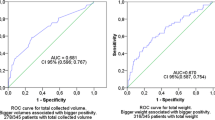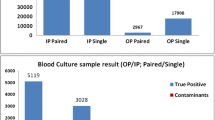Abstract
The influence of the volume of blood cultured on the rate of detection of bacteremia was evaluated in a routine 12-tube blood culture system using 1693 samples from 1502 patients. Blood samples were drawn simultaneously into two transport tubes. The blood volume cultured was the only varying parameter. Generally, 17 % more cultures with clinically significant microorganisms (bothEnterobacteriaceae and gram-positive cocci) were found when blood from two instead of one tube was used (in most cases comparing 13–16 ml of blood with 6.5–8 ml). Of the most prevalent species, the maximum average extra yield was observed forStaphylococcus aureus (26 %) followed byEscherichia coli (16 %) andStreptococcus pneumoniae (12 %). In adults most cases of bacteremia are low-grade. The grade of bacteremia in our patient population was on average as low as 0.25 CFU/ml blood. Therefore, all patients suspected of having bacteremia should have the benefit of a sufficient volume of blood cultured. Since the volume of blood cultured seems to be the single most important factor in the detection of bacteremia, it is imperative that the volume is the same in comparative studies of different blood culture systems.
Similar content being viewed by others
References
Hall, M. M., Ilstrup, D. M., Washington, J. A.: Effect of volume of blood cultured on detection of bacteremia. Journal of Clinical Microbiology 1976, 3: 643–645.
Washington, J. A.: Conventional approaches to blood culture. In: Washington, J. A. (ed.): The detection of septicemia. CRC Press, West Palm Beach, 1978, p. 41–87.
Salventi, J. F., Davies, T. A., Randall, E. L., Whitaker, S., Waters, J. R.: Effect of blood dilution on recovery of organisms from clinical blood cultures in medium containing sodium polyanethol sulfonate. Journal of Clinical Microbiology 1979, 9: 248–252.
Sandven, P., Høiby, E. A.: The importance of blood volume cultured on detection of bacteremia. Acta Pathologica Microbiologica Immunologica Scandinavica (B) 1981, 89: 149–152.
Tenney, J. H., Reller, L. B., Mirrett, S., Wang, W-L. L., Weinstein, M. P.: Controlled evaluation of the volume of blood cultured in detection of bacteremia and fungemia. Journal of Clinical Microbiology 1982, 15: 558–562.
Ilstrup, D. M., Washington, J. A.: The importance of volume of blood cultured in the detection of bacteremia and fungemia. Diagnostic Microbiology and Infectious Diseases 1983, 1: 107–110.
Shanson, D. C., Thomas, F., Wilson, D.: Effect of volume of blood cultured on detection ofStreptococcus viridans bacteremia. Journal of Clinical Pathology 1984, 37: 568–570.
Plorde, J. J., Tenover, F. C., Carlson, L. G.: Specimen volume versus yield in the Bactec blood culture system. Journal of Clinical Microbiology 1985, 22: 292–295.
Henry, N. K., McLimans, C. A., Wright, A. J., Thompson, R. L., Wilson, W. R., Washington, J. A.: Microbiological and clinical evaluation of the Isolator lysiscentrifugation blood culture tube. Journal of Clinical Microbiology 1983, 17: 864–869.
Kreger, B. E., Craven, D. E., Carling, P. C., McCabe, W. R.: Gram-negative bacteremia. III. Reassessment of etiology, epidemiology and ecology in 612 patients. American Journal of Medicine 1980, 68: 332–343.
Arpi, M., Prag, J., Schrøder, S. S., Bentzon, M. W., Frederiksen, W.: Comparative analysis of two blood culture systems (Isolator and a 12-tube system) by cumulative differences in detection power at different times during incubation. Acta Pathologica Microbiologica Immunologica Scandinavica 1988, 96: 455–463.
Arpi, M., Lester, A., Frederiksen, W.: A comparison of a conventional and a radiometric examination of clinical blood cultures with respect to recovery rate and detection time of microorganisms. Acta Pathologica Microbiologica Immunologica Scandinavica (B) 1985, 93: 263–271.
Lautrop, H., Høiby, N., Bremmelgaard, A., Korsager, B.: Bakteriologiske undersøgelsesmetoder. FADL's Forlag, København, Århus 1979, p. 1–416.
Hansen, B. G.: Etiologic importance of coagulasenegativeMicrococcaceae isolated from blood cultures, Acta Pathologica Microbiologica Immunologica Scandinavica (B) 1985, 93: 1–6.
Henrichsen, J.: Recent trends of isolates from cases of bacteremia in Denmark. Scandinavian Journal of Infectious Diseases 1974, 6: 145–151.
Bruun, B., Sloth, K., Benzon, M. W., Frederiksen, W.: A study of bacteremias in Denmark from 1977–1978. Acta Pathologica Microbiologica Immunologica Scandinavica (B), 1982, 90: 309–317.
Sullivan, D. T., LaScolea, L. J., Neter, E.: Relationship between the magnitude of bacteremia in children and the clinical disease. Pediatrics 1982, 69: 699–702.
Durbin, W. A., Szymczak, E. G., Goldmann, D. A.: Quantitative blood cultures in childhood bacteremia. Journal of Pediatrics 1978, 92: 778–780.
Washington, J. A., Ilstrup, D. M.: Blood cultures: issues and controversies. Reviews of Infectious Diseases 1986, 8: 792–802.
Washington, J. A.: Blood cultures: principles and techniques. Mayo Clinic Proceedings 1975, 50: 91–98.
LaScolea, L. J., Rosales, S. V., Welliver, R. C., Ogra, P. L.: Mechanisms underlying the development of meningitis or epiglottitis in children afterHaemophilus influenzae type b bacteremia. Journal of Infectious Diseases 1985, 151: 1162–1165.
Author information
Authors and Affiliations
Rights and permissions
About this article
Cite this article
Arpi, M., Bentzon, M.W., Jensen, J. et al. Importance of blood volume cultured in the detection of bacteremia. Eur. J. Clin. Microbiol. Infect. Dis. 8, 838–842 (1989). https://doi.org/10.1007/BF02185857
Issue Date:
DOI: https://doi.org/10.1007/BF02185857




